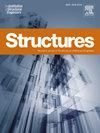Experimental investigation of the critical collapse behaviour of stiffened box girders under impact bending load
IF 4.3
2区 工程技术
Q1 ENGINEERING, CIVIL
引用次数: 0
Abstract
For steel thin-walled girders, the loading capacity and failure modes under impact bending load will be significantly different from the static load condition. Critical collapse states, when collapse occurs, are difficult to pinpoint due to the extremely short duration of the impact load and the steady increase in structural deformation. The critical collapse state of the box girders under impact loading should be defined considering the progressive failure process of yielding or buckling from the expansion of local structural members into global regions. In this paper, seven impact experiments were conducted using a drop hammer facility to investigate the failure mechanism and dynamic capacity of the box girders under the impact bending. Three identical girders, fabricated using the same material and welding process, were designed. Seven impact cases were performed, each with varying impact velocities, to measure hammer acceleration, structural strain, and structural displacement. For a smooth transition from intact to collapsed girder in tests, replace it once major plastic deformation occurs. The experimental results were used to obtain the curves of impact load and structural dynamic response. Numerical studies were conducted using the finite element method (FEM) to investigate the dynamic response of girders under various impact velocities, and the results were compared with the experimental results. The critical collapse state of the girder under impact bending was determined. Based on the FEM results for the additional girders of various scantlings, the critical impact velocity of the girders is shown to be related to the cross-section properties. These conclusions are useful for assessing the safety of the box girders under impact bending loads.
冲击弯曲荷载作用下加劲箱梁临界倒塌特性试验研究
对于薄壁钢梁来说,在冲击弯曲荷载作用下的承载能力和破坏模式与静载条件下会有明显的不同。由于冲击载荷持续时间极短,结构变形不断增大,因此很难确定发生坍塌时的临界坍塌状态。箱梁在冲击荷载作用下的临界破坏状态应考虑局部构件向整体区域扩展的屈服或屈曲的渐进破坏过程。采用落锤试验装置进行了7次冲击试验,研究了箱梁在冲击弯曲作用下的破坏机理和动力能力。设计了三根相同的大梁,采用相同的材料和焊接工艺制作。在不同的冲击速度下,进行了7个冲击案例,以测量锤加速度、结构应变和结构位移。为了在试验中从完整梁到倒塌梁的平稳过渡,在发生较大塑性变形时更换。利用试验结果得到了冲击载荷和结构动力响应曲线。采用有限元法对不同冲击速度下的梁的动力响应进行了数值研究,并与试验结果进行了比较。确定了梁在冲击弯曲作用下的临界破坏状态。基于不同尺寸附加梁的有限元计算结果,表明附加梁的临界冲击速度与截面特性有关。这些结论对箱梁在冲击弯曲荷载作用下的安全性评估具有一定的指导意义。
本文章由计算机程序翻译,如有差异,请以英文原文为准。
求助全文
约1分钟内获得全文
求助全文
来源期刊

Structures
Engineering-Architecture
CiteScore
5.70
自引率
17.10%
发文量
1187
期刊介绍:
Structures aims to publish internationally-leading research across the full breadth of structural engineering. Papers for Structures are particularly welcome in which high-quality research will benefit from wide readership of academics and practitioners such that not only high citation rates but also tangible industrial-related pathways to impact are achieved.
 求助内容:
求助内容: 应助结果提醒方式:
应助结果提醒方式:


